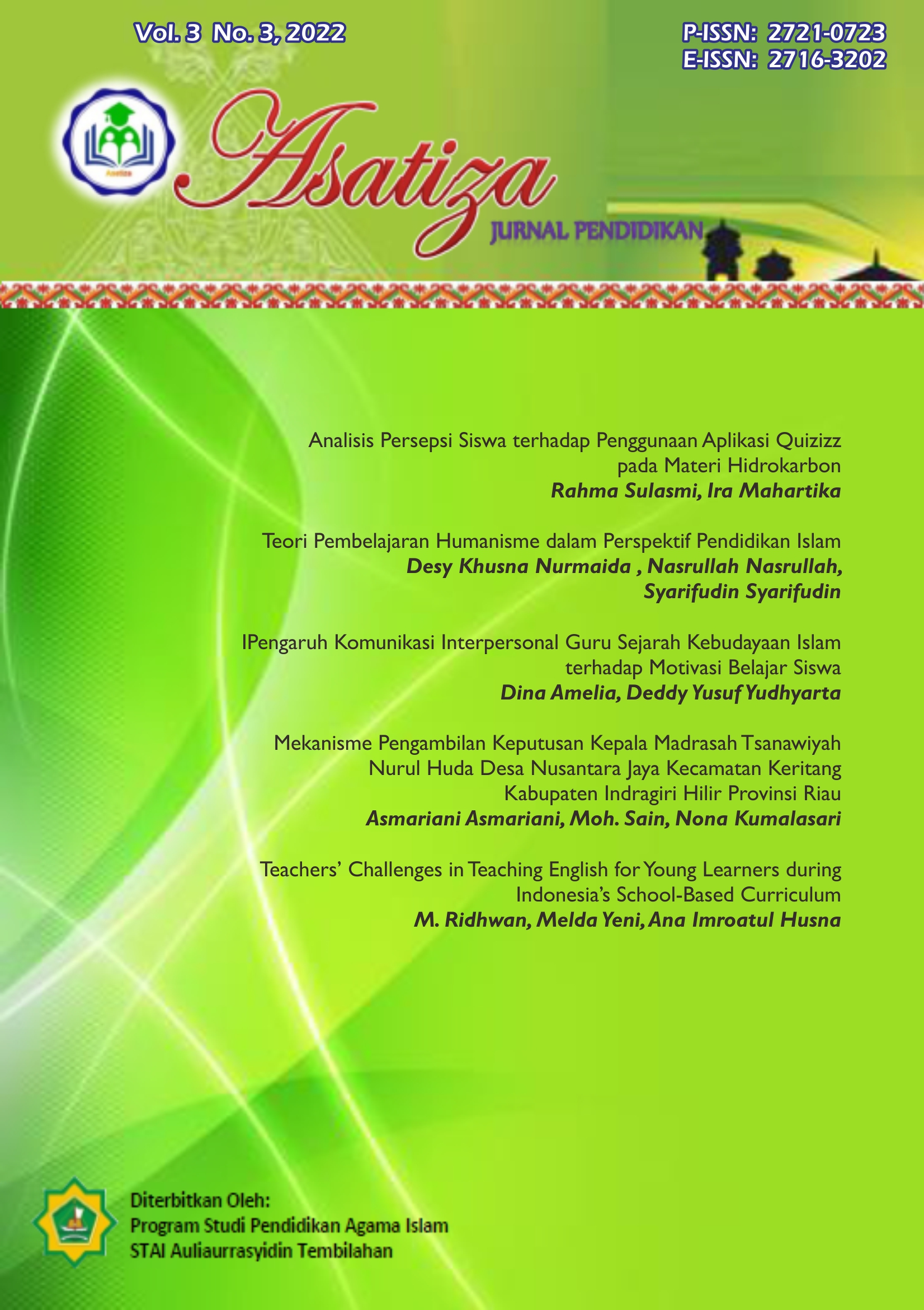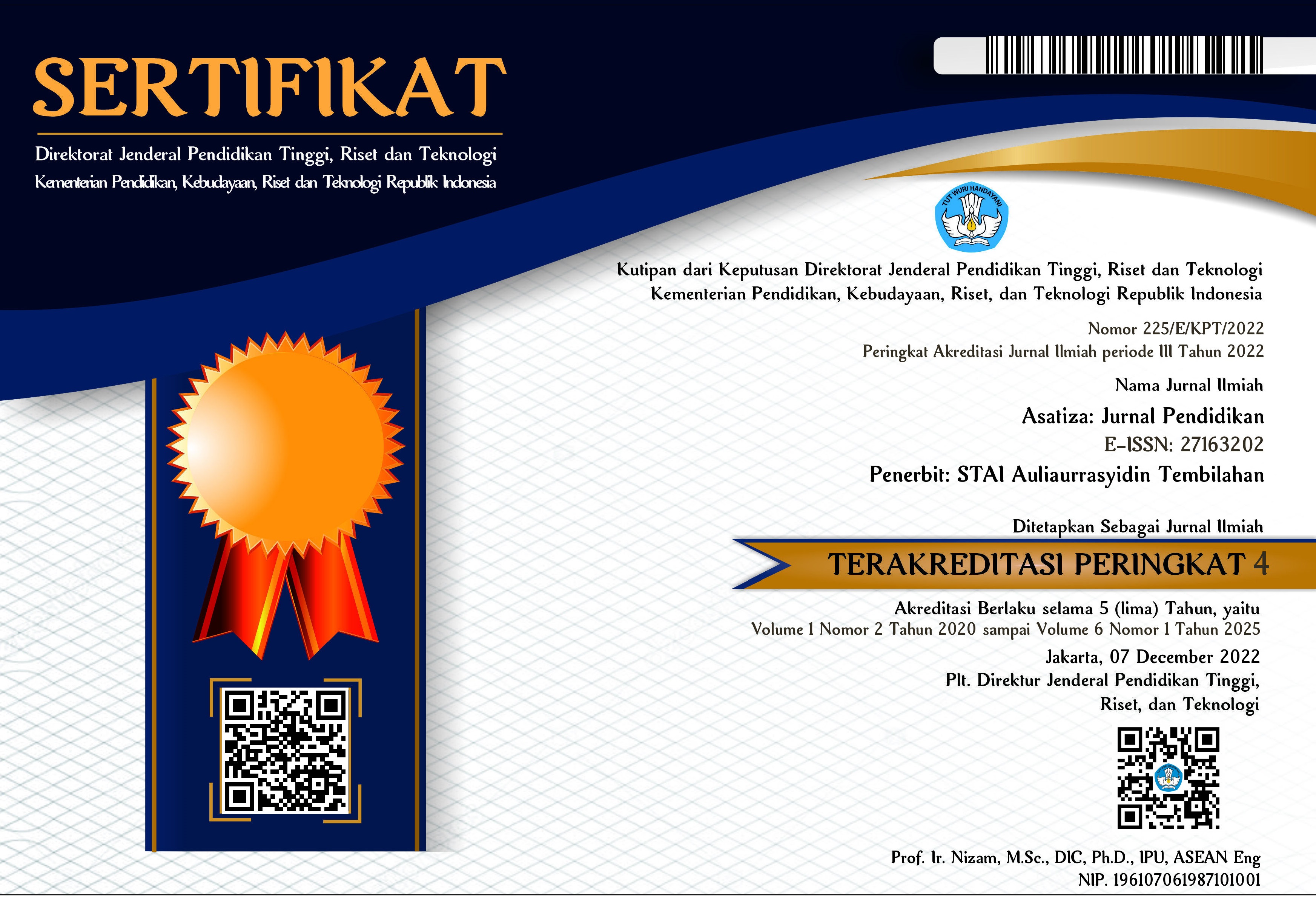Pengaruh Komunikasi Interpersonal Guru Sejarah Kebudayaan Islam Terhadap Motivasi Belajar Siswa
DOI:
https://doi.org/10.46963/asatiza.v3i3.739Keywords:
Interpersonal Communication, Learning Motivation, Islamic Cultural HistoryAbstract
The purpose of this study was to determine the effect of interpersonal communication of Islamic cultural history teachers on the learning motivation of class IX.4 students at Madrasah Tsanawiyah Negeri 2 Indragiri Hilir. The research method with a quantitative approach uses data collection techniques, namely questionnaires and documentation. While the data analysis technique uses a simple regression analysis formula. The population in this study were all students of class IX.4, totaling 36 students. The results showed that the effect of interpersonal communication on teachers of Islamic cultural history reached 64.32% and the influence of student learning motivation reached 60.73%. There was also the effect of interpersonal communication on teachers of Islamic cultural history on student learning motivation in class IX.4 which is indicated by F. count ≥ F table, then Ho is rejected, meaning it is significant, namely F count 10.43 ≥ F table 4.13, then Ho is rejected, and Ha is accepted.
Downloads
References
Abd. Rahim Mansyur (2021). Komunikasi Pendidikan Guru Madrasah Ibtidaiyah dalam Jaringan (DARING). Education and Learning Journal, 2, (1). http://dx.doi.org/10.33096/eljour.v2i1.78
Darmadi. (2017). Pengembangan Model dan Metode Pembelajaran Dalam Dinamika Belajar Siswa,. Yogyakarta: CV Budi Utama.
Donni Juni Priansa. (2014). Kinerja dan Profesionalisme Guru. Bandung: CV Alfabeta.
Depdiknas. (2008). Kamus Bahasa Indonesia. Jakarta: Pusat bahasa.
Elva Ronaning Roem Sarmiati (2019). Komunikasi Interpersonal. Malang: CV IRDH.
Hamdani. (2011). Strategi Belajar Mengajar. (Bandung: Pustaka Setia.Hamzah B, Uno. &. Nurdin Mohamad (2013). Belajar dengan Pendekatan PAILKEM: Pembelajaran Aktif, Inovatif, Lingkungan, Kreatif, Efektif, Menarik. Jakarta: Bumi Aksara.
Hamzah B, Uno. (2017). Teori Motivasi & Pengukuranya: Analisis Dibidang Pendidikan. Jakarta: Bumi Aksara.
Juliansyah Noor (2011). Metode Penelitian Skripsi, Tesis, Disertasi & Karya Ilmiah. Jakarta: Kencana.
Masnur Muslich (2018). Pendidikan Karakter: Menjawab Tantangan Krisis Multidimensional. Jakarta: Bumi Aksara.
Muhammad Kusman. (2019). Pengaruh Komunikasi Interpersonal Guru terhadap Motivasi Belajar Siswa di Sekolah Menengah Atas. (V. 2. 1, Ed.) Jurnal Pendidikan Al-Tarbiyah, Vol. 29 No. 1, Desember 2019, hlm 97.https://syekhnurjati.ac.id/jurnal/index.php/tarbiyah/article/view/5170
Muhammad Aidil Aqsar. (2018). Komunikasi Dalam Pendidikan. Jurnal Al-Had, Volume III No.2 (Januari-Juni, 2018), 699. https://jurnal.pancabudi.ac.id/index.php/alhadi/article/view/356
Novan Ardy Wiyani. (2014). Praktik, dan Strategi Membumikan Pendidikan Karakter di SD. Jogjakarta: Ar-Ruzz Media.
Nurani Soyomukti (2012). Pengantar Ilmu Komunikasi. Yogyakarta: Ar-Ruzz Media.
Onong Uchjana Effendy (2008). Dinamika Komunikasi. Bandung: Remaja Rosdakarya.
Omar.Hamalik, (2001). Proses Belajar Mengajar. Jakarta: Bumi Aksara.
Redi Panuju, (2018). Pengantar Studi Ilmu Komunikasi. Jakarta: Prenamedia Group.
Rayudaswati Budi. (2010). Pengantar Ilmu Komunikasi. Makassar: Kretakupa Print
Rohinah M. Noor. (2012). The Hidden Curriculum Membangun Karakter Melalui Kegiatan Ekstrakulikuler. Yogyakarta: Insan Madani.
Sardiman. (2016). Interaksi Dan Motivasi Belajar Mengajar. Jakarta: PT Raja Grafindo Persada.
Sudarwan D. (2010). Pengantar Kependidikan. Bandung: CV. Alfabeta.
Mohamad Syarif Sumantri. (2015). Strategi Pembelajaran Teori dan Praktik Di Tingkat Pendidikan Dasar. Jakarta: Rajawali Pers.
Suranto, A. (2011). Komunikasi Interpersonal, Yogyakarta: Graha Ilmu,.
Wina Sanjaya. (2008). Perencanaan Desain Sistem Pembelajaran. Jakarta: Kencana.
Downloads
Published
Issue
Section
License
Copyright (c) 2022 Dina Amelia, Deddy Yusuf Yudhyarta

This work is licensed under a Creative Commons Attribution-ShareAlike 4.0 International License.
Authors who publish with this journal agree to the following terms:
1. Copyright on any article is retained by the author(s).
2. The author grants the journal, right of first publication with the work simultaneously licensed under a Creative Commons Attribution shareAlike 4.0 International License that allows others to share the work with an acknowledgment of the work’s authorship and initial publication in this journal.
3. Authors are able to enter into separate, additional contractual arrangements for the non-exclusive distribution of the journal’s published version of the work (e.g., post it to an institutional repository or publish it in a book), with an acknowledgment of its initial publication in this journal.
4. Authors are permitted and encouraged to post their work online (e.g., in institutional repositories or on their website) prior to and during the submission process, as it can lead to productive exchanges, as well as earlier and greater citation of published work.
5. The article and any associated published material is distributed under the Creative Commons Attribution-ShareAlike 4.0 International License











2.png)



